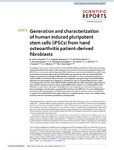Mostrar o rexistro simple do ítem
Generation and Characterization of Human Induced Pluripotent Stem Cells (iPSCs) From Hand Osteoarthritis Patient-Derived Fibroblasts
| dc.contributor.author | Castro Viñuelas, Rocío | |
| dc.contributor.author | Sanjurjo-Rodríguez, Clara | |
| dc.contributor.author | Piñeiro-Ramil, María | |
| dc.contributor.author | Hermida Gómez, Tamara | |
| dc.contributor.author | Rodríguez-Fernández, Silvia | |
| dc.contributor.author | Oreiro, Natividad | |
| dc.contributor.author | De-Toro, Javier | |
| dc.contributor.author | Fuentes Boquete, Isaac Manuel | |
| dc.contributor.author | Blanco García, Francisco J | |
| dc.contributor.author | Díaz-Prado, Silvia | |
| dc.date.accessioned | 2020-03-27T11:14:47Z | |
| dc.date.available | 2020-03-27T11:14:47Z | |
| dc.date.issued | 2020-03-06 | |
| dc.identifier.citation | Castro-Viñuelas R, Sanjurjo-Rodríguez C, Piñeiro-Ramil M, et al. Generation and characterization of human induced pluripotent stem cells (iPSCs) from hand osteoarthritis patient-derived fibroblasts. Sci Rep. 2020;10:4272 | es_ES |
| dc.identifier.issn | 2045-2322 | |
| dc.identifier.uri | http://hdl.handle.net/2183/25258 | |
| dc.description.abstract | [Abstract] Knowledge and research results about hand osteoarthritis (hOA) are limited due to the lack of samples and animal models of the disease. Here, we report the generation of two induced pluripotent stem cell (iPSC)-lines from patients with radiographic hOA. Furthermore, we wondered whether these iPSC-lines carried single nucleotide polymorphisms (SNPs) within genes that have been associated with hOA. Finally, we performed chondrogenic differentiation of the iPSCs in order to prove their usefulness as cellular models of the disease. We performed a non-integrative reprogramming of dermal fibroblasts obtained from two patients with radiographic rhizarthrosis and non-erosive hOA by introducing the transcriptional factors Oct4, Sox2, Klf4 and c-Myc using Sendai virus. After reprogramming, embryonic stem cell-like colonies emerged in culture, which fulfilled all the criteria to be considered iPSCs. Both iPSC-lines carried variants associated with hOA in the four studied genes and showed differences in their chondrogenic capacity when compared with a healthy control iPSC-line. To our knowledge this is the first time that the generation of iPSC-lines from patients with rhizarthrosis and non-erosive hOA is reported. The obtained iPSC-lines might enable us to model the disease in vitro, and to deeper study both the molecular and cellular mechanisms underlying hOA. | es_ES |
| dc.description.sponsorship | This study was carried out thanks to the funding from Fundación Española de Reumatología (Proyectos 2014), Proyectos de Investigación 2016 (PI16/02124) and 2017 (PI17/02197) from Instituto de Salud Carlos III-General Subdirection of Assesment and Promotion of the Research – European Regional Development Fund (FEDER) “A way of making Europe”, Rede Galega de Terapia Celular and Grupos con Potencial de Crecemento, Xunta de Galicia (R2016/036, R2014/050, CN2012/142 and GPC2014/048); Deputación da Coruña (BINV-CS/2015); University of A Coruña; Centro de Investigación Biomédica en Red-Bioingeniería, Biomateriales y Nanomedicina (CIBER-BBN). Rocío Castro-Viñuelas, María Piñeiro-Ramil and Silvia Rodríguez-Fernández are granted by a predoctoral fellowship from Xunta de Galicia and European Union (European Social Fund) and Clara Sanjurjo-Rodríguez is beneficiary of a postdoctoral fellowship from Xunta de Galicia | es_ES |
| dc.description.sponsorship | Xunta de Galicia; R2016/036 | es_ES |
| dc.description.sponsorship | Deputación da Coruña; BINV-CS/2015 | es_ES |
| dc.description.sponsorship | Xunta de Galicia; R2014/050 | |
| dc.description.sponsorship | Xunta de Galicia; CN2012/142 | |
| dc.description.sponsorship | Xunta de Galicia; GPC2014/048 | |
| dc.language.iso | eng | es_ES |
| dc.publisher | Nature Research | es_ES |
| dc.relation | info:eu-repo/grantAgreement/MINECO/Plan Estatal de Investigación Científica y Técnica y de Innovación 2013-2016/PI16%2F02124/ES/Determinación de índices predictivos de diagnóstico y pronóstico de artrosis de rodilla mediante la validación de biomarcadores proteicos/ | |
| dc.relation | info:eu-repo/grantAgreement/MINECO/Plan Estatal de Investigación Científica y Técnica y de Innovación 2017-2020/PI17%2F02197/ES/Células madre pluripotentes inducidas (iPS) como modelo de artrosis de manos/ | |
| dc.relation.uri | https://doi.org/10.1038/s41598-020-61071-6 | es_ES |
| dc.rights | Creative Commons Attribution 4.0 International Licence (CC-BY 4.0) | es_ES |
| dc.rights.uri | http://creativecommons.org/licenses/by/4.0/ | * |
| dc.title | Generation and Characterization of Human Induced Pluripotent Stem Cells (iPSCs) From Hand Osteoarthritis Patient-Derived Fibroblasts | es_ES |
| dc.type | info:eu-repo/semantics/article | es_ES |
| dc.rights.access | info:eu-repo/semantics/openAccess | es_ES |
| UDC.journalTitle | Scientific Reports | es_ES |
| UDC.volume | 10 | es_ES |
| UDC.issue | 1 | es_ES |
| UDC.startPage | 4272 | es_ES |
Ficheiros no ítem
Este ítem aparece na(s) seguinte(s) colección(s)
-
GI-TCMR - Artigos [126]
-
INIBIC- REUMA - Artigos [184]
-
INIBIC-TCMR - Artigos [102]







